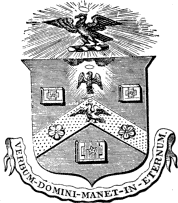The History of the Copyright Symbol
The bizarre history of a very common symbol.

The copyright symbol (©) is one of the most ubiquitous and most easily-recognized symbols in the world.
It is literally on everything. You can find it anywhere from the places you’d expect, such as books and movies, to virtually anything with writing or images on it include tissue boxes and (the most bizarre in my office) cans of compressed air.
Its inclusion is a bit strange. In most of the world, including the United States (since 1989), there’s no requirement to include any kind of notice to claim copyright in a work. Copyright exists by fixing the work into a tangible medium of expression.
Still, the copyright symbol is everywhere. and we see it hundreds of times a day, usually without thinking about it.
But where did the copyright symbol come from and how did it get started? Why is it so much less useful today? To answer those questions we have to go back to a much earlier time, back before the copyright symbol existed but it probably would have been very welcome.
Before the Copyright Symbol

Before the symbol we all know today, there were a variety of symbols and marks used to indicate copyright or some other official status. This was especially true in the times when “copy right” was used as tool to restrict what printers could publish as the symbol, usually some form of a seal, indicated that the permission was granted and that the book was authentic.
Copyright notices, however, didn’t become an element of United States law until the Copyright Act of 1802. It required publishers, if they wished to enjoy copyright protection to insert a copyright notice in their books, to publish a copyright notice either on the title page or the page behind it.
That notice was very specific and read as follows:
Entered according to act of Congress, the _____ day of _____ 18 _____ (here insert the date when the same was deposited in the office) by A. B. of the State of _____ (here insert the author’s or proprietor’s name and the State in which he resides).
If that sounds like a mouthful, it certainly is but all copyrighted works had to include it. The Copyright Act of 1870 gave some reprieve to works of fine art, allowing it to be inscribed on the side that would be mounted. An amendment four years later would shorten that lengthy notice to just “Copyright, 18__, by A. B.”
To those in the 21st century, this is a much more familiar notice and closely mirrors the notices that we use today. However, there’s no copyright symbol involved. Instead, we are just using the word “Copyright”.
The actual symbol would come around in the nearly 20th century.
The Birth of the Copyright Symbol
The Copyright Act of 1909 was a major rewrite of the United States copyright code. Among other things it extended the term of copyright from a maximum of 42 years to a maximum of 56 years.
However, like most sweeping reforms, the act had many points of contention. One of them was how to apply the notice requirement to various types of works. Something of a compromise was struck.
For most works, a notice would require either the word “Copyright” or the abbreviation “Copr.” (this is a terrible abbreviation and they should feel bad). However, for maps, copies of art, photographs and prints, they introduced a new symbol.
“The notice may consist of the letter C inclosed (sic) within a circle, thus: ©, accompanied by the initials, monogram, mark or symbol of the copyright proprietor…”
It wouldn’t be until 1954 when the symbol would be considered an acceptable alternative for the word “copyright” on all types of works.
However, that was oddly the least important thing to happen to the copyright symbol around that time. The symbol was also starting to go international.
Becoming an International Symbol
In the 1950s the United States had a problem. Copyright was becoming a much more international affair but was not a member of the Berne Convention, the leading international treaty on copyright at the time.
The specific issue was these very formalities. The Berne Convention required that all nations remove such formalities, including notices and registrations. The United States wasn’t prepared to do that at the time.
This brought about the Universal Copyright Convention. It was created in 1952 and took effect in 1955. It harmonized copyright between the various signatory countries and, most importantly, ensure that works in UCC countries would be protected in Berne Convention countries and vice-versa.
Another key point was that, in countries that required formalities, they would have to treat foreign works the same as they had been registered in the state. However, that was only if they carried the © symbol and state the name of the owner.
To be clear, the prominence of the United States meant that many international works used copyright notices well before this. However, the UCC took the copyright symbol international, with many, including in countries outside of the UCC bloc, using it to ensure that their work was properly protected in the United States.
However, the UCC did not have a long life. In March 1989, the United States finally joined the Berne Convention (more than a century after the first signatories). Around that same time, negotiations began on the Agreement on Trade-Related Aspects of Intellectual Property Rights (TRIPS), which would take effect in January 1995.
Signing on to TRIPS was a requirement of joining the World Trade Organization and the TRIPS agreement also got rid of formalities and is currently the leading trade agreement on matters of copyright.
In just a few decades, the copyright symbol went from an international fixture to, in many cases, nearly useless. That said, it has clearly stuck around. You would be hard-pressed to find a book, album or movie that doesn’t have it.
But is it really useless? The answer is: Not completely.
The Continued Use of the Copyright Symbol
Under U.S. law, there’s really no requirement that you use a copyright symbol. You aren’t going to lose your copyright if you omit it (as with Night of the Living Dead) and, most likely, nothing bad will happen if you forget it.
One area where a copyright notice (including the symbol) still has an impact is with “innocent infringers”. Innocent infringers are subject to significantly lowered damages however, with the presence of a proper copyright notice, such a defense is impossible.
Ultimately, the much more likely way a copyright notice can benefit a creator is that it prevents some infringements. Given that some still believe works without copyright notices are public domain, including a notice (including the symbol) might stop at least some infringers.
Given that it doesn’t cost anything to include a copyright notice and it’s so common and ubiquitous, there isn’t really a reason not to. If it has any benefit at all, that’s more than enough to justify its inclusion for most.
Bottom Line
The copyright symbol is the face of copyright. It is one of the most common symbols we see on a daily basis and, yet, it’s something we think about very little. It’s just something that’s always been there and never really warranted questioning.
However, it’s a symbol that has a surprisingly colorful history and one that illustrates many of the problems with any kind of copyright formalities.
Still, one has to admit that its continued widespread use is somewhat bizarre. It’s extremely limited benefits outweigh the even more significantly limited costs. There’s little reason to have it but even less reason not to have it.
So, the copyright symbol lives on. Archaic and nearly useless, it remains just as common.
It’s a long, bizarre history of a very mundane thing.
Want to Reuse or Republish this Content?
If you want to feature this article in your site, classroom or elsewhere, just let us know! We usually grant permission within 24 hours.
